Syzygium: A Jumble of Jambul
The Jambul tree makes you wonder what people were thinking.
For a half a century or so the United States Department of Agriculture brought into Florida many species the state now considers problem plants. Jambul is one of them. It was introduced into south Florida as a shade tree, not once but three times, 1911, 1912 and 1920. It took 71 years for the species to become a naturalized pest and now a century later full-grown specimens can be found in the warm south of the state to central Florida. Not bad for a tropical tree.
The species has been introduced into most warm areas of the world. However, in Hawaii it probably got there by migrating mynah birds and was first recorded on the islands in 1870. That state is trying to eradicate it. Jambul was also cultivated throughout the Caribbean and got to Puerto Rico in the 1920s, where it’s naturalized as well. Because of its later introduction there it is one of the few genera in the Caribbean that is not used much in local folk medicine (though very present in native India medicine.) As a forager there is little I can do about the genus except my civic duty and eat as many of its fruit as possible to reduce its spread. Actually there are at least two species of Syzygium naturalized in Florida, the S. cumini that bears dark purple fruit, above, and S. jambos, below, which has white to red fruit. Both species are called the Jambul tree (jam-BULL.)
A native of south Asia and Australia Jambul produces food, wood products, and materials for folk medicine. The dark fruit of the S. cumini tastes and smells like a ripe apricot but looks like a stretched black olive, very juicy and to me puckery like a chokecherry. The S. jambos has pearish-shaped fruit that ranges from white to green to yellow to red. Its flavor is more like an apple/green pepper cross with a rose scent and a slightly bitter aftertaste. It’s skin is thin, waxy, and the hollow core contains a small amount of inedible fluff.
Jambul fruit, which are high in vitamins C, can be eaten out of hand or made into sauces, tarts and jams. They make a good fruit sherbet, syrup and squash. They can be made into vinegar, wine or distilled, one native spirit being “jambava.” It is also a good honey tree. Harvesting of fruit in its native range is in summer or early fall. Here in Florida it tends to be in spring to summer. The leaves make good livestock feed and oil in the leaves has been used to scent soaps and perfumes. The bark yields a brown dye and has tannin for leather making. The wood is very durable to water. It’s used used to make beams, rafters, telephone poles, oars, ship masts, boats, and water troughs, among many more uses.
Often planted as a windbreak, the S. cumini trees can reach full height in 40 years, which in their native rage is near 100 feet. In Florida it is half that. It can have a crown 18 to 40 feet wide and often has multiple trunks radiating from near the ground. The Jambul can also grow in wet and dry areas as long as it has sun. The bark on the lower part of the tree is discolored, rough textured, cracked and flaking; young bark higher up is smooth and light gray. The paired, opposite leaves have a hint of turpentine when crushed. The evergreen leaves are two to ten inches long, one to four inches wide, oblong in shape, oval or elliptic, can be blunt or tapering to a point at the tips. The leaves start out pinkish then mature leathery and glossy, dark green above, light green below. Each leaf has a yellowish midrib. The S. jambos tends to be shorter, perhaps 45 feet at best in its native range, its leaves are more lance shaped, and the bark a smooth gray.
Medicinally the seeds of the Jambul have been used to control blood sugar levels and the leaves and bark high blood pressure. Incidentally, we regularly used another member of this genus, S. aromaticum. Its dried flower buds form the spice we know as “cloves.”
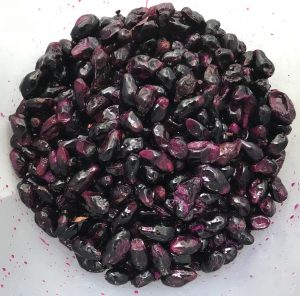
Jambul Fruit being made into wine. Photo by Green Deane
As is often the case the botanical name is Greek tainted by Latin. Syzygium is said to refer to the tree’s paired leaves, one also sees “twin” leaves. The base word, however, is zygos (zi-GHOS) the yoke. A person’s spouse in Greece is called my Zizigos (ZEE-zee-ghos) my yoke mate. So the Greek speaker would be strongly tempted to pronounce Syzygium as zee-ZEE-ee-yum. Anglicized Latin would have it sizz-ZYE-gee-um.The species name cumini, said KOU-mee-nee, is from the Greek kyminon (KEY-mee-on) or in modern Greek Kymino (KEY-mee-no) meaning the spice cumin. Jambos (jam-BOS) is the Malaysian name for rose-apple though it comes from Sanskrit’s Jambudvīpa, which means rose apple land.
Green Deane’s “Itemized” Plant Profile
IDENTIFICATION: S. cumini is a tree to 50 feet, S. jambos smaller, both often multiple trunks, bark on the lower part of S. cumini is discolored, rough textured, cracked and flaking, young bark higher up is smooth and light gray, bark on S. jambos smooth and gray. Paired opposite leaves have a hint of turpentine when crushed. The evergreen leaves of the S. cumini are two to ten inches long, one to four inches wide, oblong in shape, oval or elliptic, can be blunt or tapered to a point at tips, leaves of the S. jambos more lance shaped. Leaves start out pinkish then mature leathery and glossy, dark green above, light green below. Each leaf has a yellowish midrib.
TIME OF YEAR: Summer and fall in native range, late spring and summer in Florida area.
ENVIRONMENT: Likes sun, can tolerate wet and dry conditions, does not tolerate freezes unless full grown then iffy.
METHOD OF PREPARATION: Fruit out of hand, or use as any fruit as jelly, sauce, syrup, wine, spirits and vinegar.

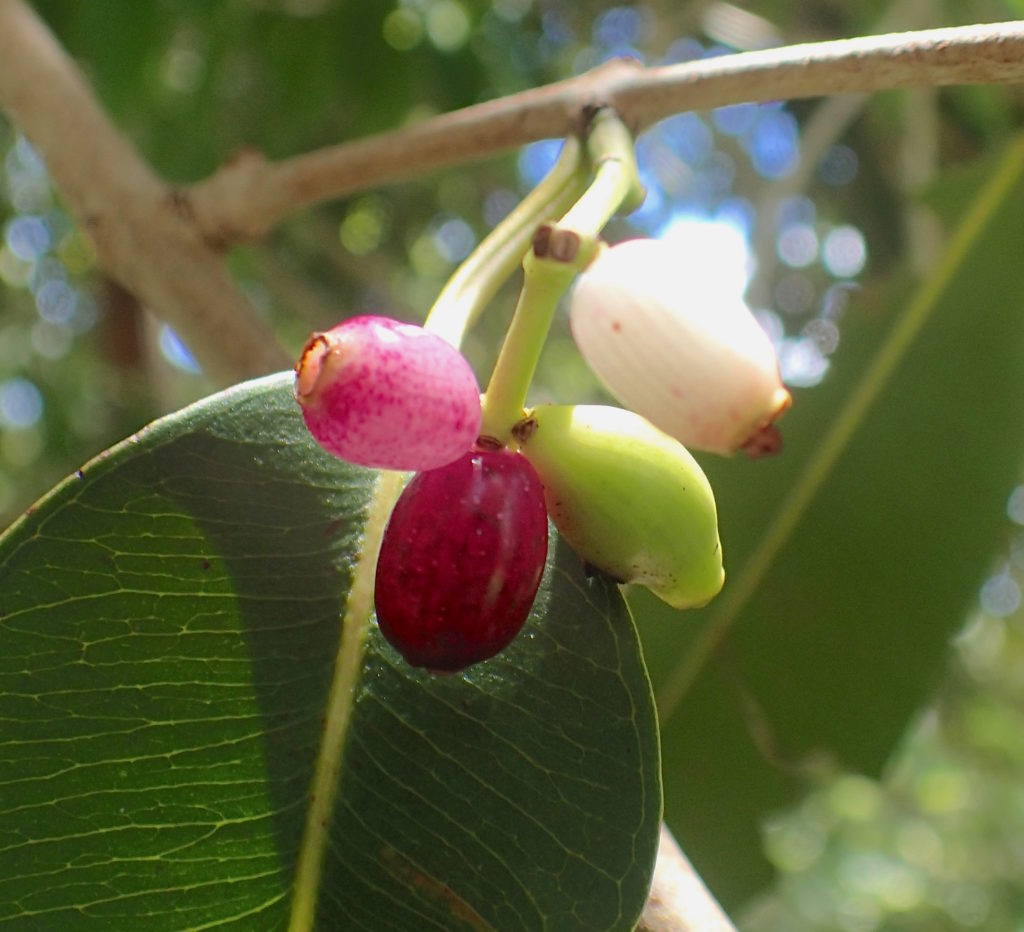
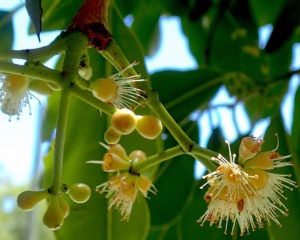
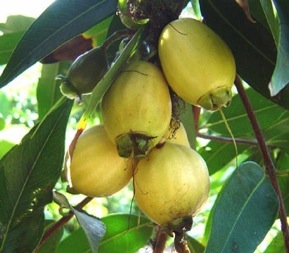
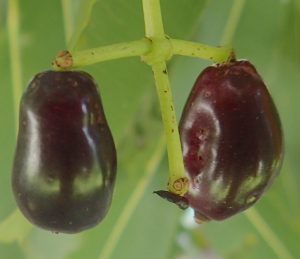
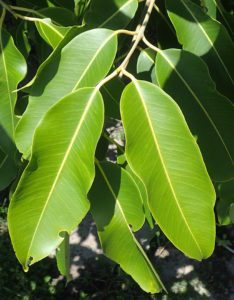

there are alot of syzygium species here in sydney, one i just tried this morning, s. moorei, which has white golf ball size fruits. it tasted like alum, or cheezy even. afterwards i discovered ti is an effective breath freshening treatment. my mouth feels so clean!
Bought a carton of jambul juice at the East Indian store recently. It was delicious! Thanks for the info about the jambul, glad to know we have it Florida.
Hi, There’s a photo of Rose Apple that’s labeled Jambul.
I want to try to plant them here in Las Vegas. Can you send me some seeds if I will send you a stamped envelope? Thanks.
I would like to comment that the jambul is known in Puerto Rico as pomarrosa or pomarosa. My uncle had a bunch of mature trees on his property line and when in fruit we ate them until we got sick. The type he had was white fruit with a red blush. To me they have a perfumey taste. I have never seen any of the other varieties but it’s interesting to know! Thanks.
Live in the Orlando area and was wondering where I could get some small plants or seeds of the S.Cumini. Also can you keep it at the bush height or in a large pot or does it have to have space to grow into a tree?
I don’t know of sources as I don’t sell seed though I am asked to. A nursery in south Florida might be able to help you, though.
I have some small sapplings about a year grown. If your ever in Davie Florida stop by and give them a good home.
I’m from Atlanta Ga. i’m wondering what store can we purchase seeds & leaves of jambul from.
I have 4 full grown trees if you need seeds I have all you could want. No charge just pay for the shipping 👍.
Why is the species named after the spice cumin? Doesn’t sound like the flavor is related.
I think because some botanists are stupid.
Many seed companies carry this
and some nurseries carry the plant as a fruit tree.
ive grown it from seed. (S. Cumini)
it can grow quite fast.
Dean
You might check the vitamin profile again.
My understanding is its rich in several nutrients.
Also…
Not many plants actually contain vitamin D.
the only sources i know of are seafood and mushrooms.
and… sunshine… which is the best!!
Vit D is the vitamin Americans are most deficient in.
Lucky Floridians probably do not have a problem with it though.
You are right. I’m not sure how that got in there. Perhaps I typed D instead of A.
I grew up eating and enjoying jambul. It is seasonal street food in India. These days (in the US), I primarily use it to flavor some of my ciders. (I’m the only one who drinks it, lol).
i am growing Jambul
(also called Jamun, and Java plum)
in New Orleans it got to 5ft and froze back to the roots
during a freeze we had. it hit 26F.
we normally do not get temps that cold.
it is coming back from the roots, already almost 3ft tall and its only May 16th.
i am hoping the next 2-3 years we dont get a hard freeze
(we normally do not, it rarely gets under 30F, and Jambul might loose a few leaves at that temp, but otherwise not be affected)
so, hopefully i get a few years of good growth
so it can get larger and stronger to handle a frost when we do get one.
here is some info on the other plant (Jambos)
related to the water apple (not as cold tolerant)
Syzygium jambos / “rose apple”.
“plum rose”, “water apple”, “Cloud apple”
A crisp, yellow, 1-2″ long fruit with the smell and taste of rose water. The rose apple is occasionally cultivated in the tropics http://www.tradewindsfruit.com/content/rose-apple.htm
I have the Jambul Tree in a large pot & hope to keep the tree small and it’s been there a few years and it is about 5 feet tall and I keep trimming unruly growth and am wondering if it will bloom and fruit at a small height. Please advise if you have experience with this. Thank YOU!
Back in the early 70’s I made a five gallon batch of java wine.
I think today I would try to blend it.
The fruit would drop on my car and driveway and leave stains then draw flys.
Overall I have good memories.